
Lupine Publishers Group
Lupine Publishers
Menu
ISSN: 2641-1709
Research Article(ISSN: 2641-1709) 
Anxiety and Language Development Correlation in Hearing Impaired Children Volume 3 - Issue 3
Rabea Al1, Safinaz Nagib Azab2*, Mohamed Rabea AL Sabealah3, Ebaa Ahmed Al Mufadhi3 and Alia Al rawely4
- 1Professor of Otorhinolaryngology, King Abd El Aziz Specialized Hospital, Kingdome of Saudi Arabia
- 2Phoniatrics Consultant, King Abd Al Aziz Specialized Hospital, Jouf, Saudi Arabia
- 3Faculty of Medicine, Jouf University, Saudi Arabia
Received:November 11, 2019; Published:December 04, 2019
Corresponding author: Safinaz Nagib Azab, Phoniatrics Consultant, King Abd Al Aziz Specialized Hospital, Jouf, Saudi Arabia
DOI: 10.32474/SJO.2019.03.000161
Abstract
Background: Hearing is critical for normal development and acquisition of language and speech and Hearing impairment exists when there is diminished sensitivity to the sounds normally heard. Several studies have suggested that one out of every two to three school-aged children with any degree of hearing impairment have academic, social, and behavioral difficulties. Purpose: To compare the degree of hearing loss regarding the Anxiety Related Emotional Disorders of hearing-impaired children and correlates this to language scale.
Methods: 75 children divided equally to three groups, mild, moderate and severe hearing impaired Arabic speaking children aged between 6 to 8 years were included in this study and were subjected to psychometric evaluation, audiological assessment, Arabic language scale, and The Screen for Child Anxiety Related Emotional Disorders (SCARED) questionnaire(Arabic version).
Results: Hearing-impaired children showed more language, emotional difficulties, and spent less time communicating than children with normal hearing. The lowest academic, social, and emotional scores were in severe hearing-impaired group than in the other two groups.
Conclusion: Even slight/mild hearing impairment can result in negative consequences in the psychological, social, and emotional and there is significant relationship between delayed language, anxiety, and child emotionalrelated problems.
Keywords: Hearing Impairment; Psychological; Anxiety; Emotions; Language; Speech
Introduction
Hearing, auditory perception, or audition is the ability to perceive sound by detecting vibrations changes in the pressure of the surrounding medium through time, through an organ such as the ear [1]. Hearing is critical for normal development and acquisition of language and Speech [2]. Hearing impairment exists when there is diminished sensitivity to the sounds normally heard [3]. According to Smith, the term hearing impairment is usually reserved for people who have relative insensitivity to sound in the speech frequencies [4]. The severity of a hearing impairment is categorized according to the increase in volume above the usual level necessary before the listener can detect it. Along the world approximately one child in 1,000 is hearing impaired from birth, and the number rises to about 1.6 per 1,000 in adolescents. The causes are hereditary in 30-39%, acquired in 19-30% and the cause remains unknown in 31-48% of children [5]. Language plays a central role in development. It is not only the medium for social exchange, but aids in internalizing social norms and the development of behavioral control [6]. Hearing impaired children do not acquire language and speech the same as normal hearing children because they cannot hear the language spoken around them. In normal language acquisition, auditory comprehension precedes the development of language [7]. So, children who have hearing impairment as they move into school are at risk of a raft of difficulties. Impacts of poor oral language skills go well beyond early literacy development and ‘school readiness’s to increasingly apparent associations with emotional, behavioral and social difficulties [8]. Hearing impaired children can be viewed as being different from the majority because of their observable hearing aids, use of sign language, and/or their distinct speech production. Moreover, hearing impaired children’s language problems and impaired socially skilled behaviors have been frequently reported. Refs [9,10] reports that school-aged children who are hearing impaired may be as much as five times more likely to suffer from emotional disturbance, defined as a pattern of behavior that deviates from the acceptable patterns of behavior in school that impact their ability to maintain normal social relationships. Questionnaires are frequently used in quantitative Marketing research and social research. They are a valuable method of collecting a wide range of information from a large number of Individuals often referred to as respondents. Adequate questionnaire Construction is critical to the success of a survey [11].
Objectives
The aim of this work is to compare between the different degrees of hearing loss regarding the Anxiety Related Emotional Disorders of hearing-impaired children and then correlate the data to their language scale.
Subjects & Methods
This research was conducted during the period between the months November 2018 and September 2019. The study protocol was approved by the Otolaryngology Department Council of King Abd Alaziz Specialized Hospital, Jouf, Saudi Arabia. Consent to participate in this research was obtained from the subjects’ parents before commencement of the study. This study was applied on 75 child, 53 males and 22 females. Their ages ranged from [72m (6 years) to 93m (7 years and 3m)] with a mean (81.15±5.53) diagnosed as hearing impairment. They were divided into three equal groups each one consists of 25 patients.
a) Group A? (mild hearing impairment) consisted of 16 males and 9 females with age range (72m-93m) with a mean (80.08±5.83).
b) Group B? (moderate hearing impairment) consisted of 19 males and 6 females with age range (72 m-90 m) with a mean (82.96±5.22).
c) Group C? (severe hearing impairment) consisted of 18 males and 7 females with age range (72m-90m) with a mean (80.40 ± 5.29). The subjects were randomly selected from a group of typically developing children in Nurseries and schools in Jouf area. All children were coming from Families of moderate socio-economic status. They were all reported to be free from profound hearing impairment (>90db) or those with cochlear implantation, hearing impairment with other psychological disorder (Autism, ADHD), neurological or physical handicap e.g. BDMH (brain damage motor handicap) and serious medical/chronic problems. The children were diagnosed as sensorineural or conductive hearing loss: (Mildmoderate- moderate to severe and severe), all the children were fitted with either unilateral or bilateral hearing aids (according to their audio logical needs) with regular use and follow up and with minimum two years ago. Arabic spoken as a primary language (monolingual Arabic-speaking family, where Arabic is the primary language) and regular use of satisfactory hearing aids and language rehabilitation sessions twice 20 minutes per week for minimum one year. All children were subjected to the following protocol of assessment: Audio logical assessment: Many formal audio logic testing to determine the type and etiology of hearing loss and the optimal treatment plan, such as, e.g. Auditory Brainstem Response (ABR) and Pure Tone Audiometry to measure the degree of hearing impairment then classify them accordingly to mild 20-40 dB, moderate 41-70 dB and sever 71-95dB. Psychometric and cognitive assessment by Stanford-Binet Intelligence Scales Fourth Edition (SB: FE): [12]. Language assessment by Language scales [13].
Screen for child anxiety related emotional disorders (SCARED)
The Questionnaire was translated to Arabic language and back translated by two of the psychiatric staff. Then pilot study was done for checking and is sure of its reliability although it is already applied on normal hearer attending to psychiatry department so, there was no mandatory need for control group. The SCARED has 41 sentences describing various feelings and behaviors possibly associated with anxiety symptoms [14]. The SCARED was chosen to measure the children for anxiety disorder SCARED could significantly discriminate between anxious and depressed children. Items that can be grouped into five subscales. Four of these subscales measure anxiety disorder symptoms as conceptualized in the Diagnostic and Statistical Manual of Mental Disorders DSM-IVTR: panic disorder, generalized anxiety disorder, separation anxiety disorder, and social anxiety. The Scared questionnaire in this study rated each symptom on a 3-point scale: 0 (no), 1 (sometimes), or 2 (yes).The subscales of the questionnaire are: panic disorder (13 items), generalized anxiety disorder (9 items), separation anxiety disorder (8 items), and social anxiety (4 items), and school anxiety (4 items). A total score of ≥ 25 may indicate the presence of an Anxiety Disorder. Scores higher that 30 are more specific.
a) A score of 7 for items 1, 6, 9, 12, 15, 18, 19, 22, 24, 27, 30, 34, 38 may indicate Panic Disorder or Significant Somatic Symptoms.
b) A score of 9 for items 5, 7, 14, 21, 23, 28, 33, 35, 37 may indicate Generalized Anxiety Disorder.
c) A score of 5 for items 4, 8, 13, 16, 20, 25, 29, 31 may indicate
d) Separation Anxiety Disorder.
e) A score of 8 for items 3, 10, 26, 32, 39, 40, 41 may indicate Social Anxiety Disorder.
f) A score of 3 for items 2, 11, 17, 36 may indicate Significant School Avoidance.
The data was collected, coded and entered to computer. The data was analyzed with the program (SPSS) statistical package for social science version 16 under windows 7. Statistical tests used in this thesis were: description of qualitative variables by frequency and percentage, description of quantitative variables in the form of mean and standard deviation (mean ± SD) and Chi-square (x2) test was used for comparison of qualitative variables with each other. Comparison between quantitative variables was carried by using Student t-test of two independent samples while ANOVA test was used for more than two independent samples. The differences were considered significant if p<0.05. Spearman-rho method was used to test correlation between numerical variables (r > 0.3=no correlation, r=0.3-0.5=fair correlation, r=0.5-0.1=good correlation).
Results
Sex and age distribution for each group regarding mean and SD show no significant difference. Table 1 shows that there is significant difference between the three groups A, B and C (mild, moderate and sever hearing impairment) as regard the total language age. Also, there is significant difference between the three groups A, B and C (mild moderate and sever hearing impairment) as regard the IQ (Table 2). Figure 1 shows the subtypes of Child Anxiety Related Emotional Disorders (SCARED) test regard no. and % shows significant difference between the three groups A, B and C (mild, moderate and severe HI) in generalized and social disorders (p=0.0001). There was no significant difference between the three groups in panic (p=0.353), separation and school avoidance disorders (p=0.191). Figure 2 shows significant positive correlation between all children chronological ages (the three groups A, B and C) and their total language ages (R=0.0288). Figure 3 shows highly significant positive correlation between IQ scores of all children (the three groups A, B and C) and their total language ages (R=0.716). Figure 4 shows negative correlation between total language ages and Child Anxiety Related Emotional Disorders (SCARED) (R=- 0.197). Figure 5 shows significant negative correlation between anxiety scores and IQ total scores (R=0.422) of all children (the three groups A, B and C).
Figure 1: Subtypes of anxiety test regard no. and % shows significant difference between the three groups A, B and C (mild, moderate and sever hearing impairment) in generalized and social disorders (Value=0.0001) and there was no significant difference between the three groups in panic (Value=0.353), separation and school avoidance disorders (Value=0.191).
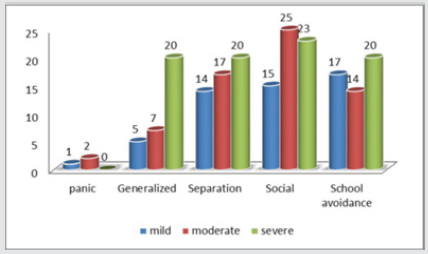
Figure 2: Shows significant positive correlation between all children chronological ages (the three groups A, B and C) and their total language ages (R=0.0288).
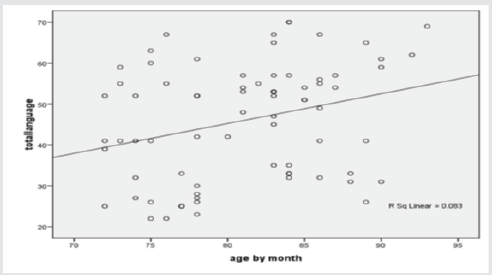
Figure 3: Highly significant positive correlation between IQ scores of all children (the three groups A, B and C) and their total language ages (R=0.716).
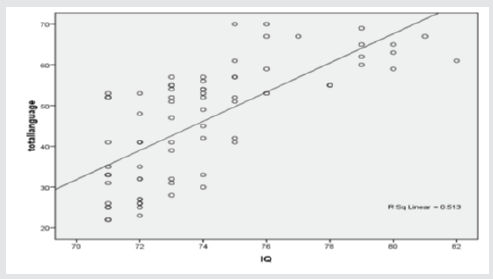
Figure 4: Significant negative correlation between total language ages and Child Anxiety Related Emotional Disorders (SCARED) (R=-0.197).
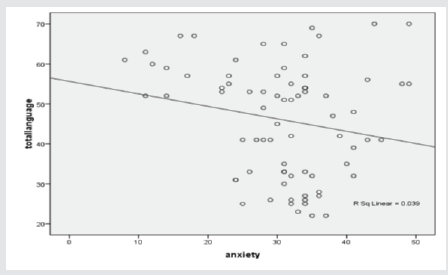
Figure 5: Significant negative correlation between anxiety scores and IQ total scores (R=0.422) of all children (the three groups A, B and C).
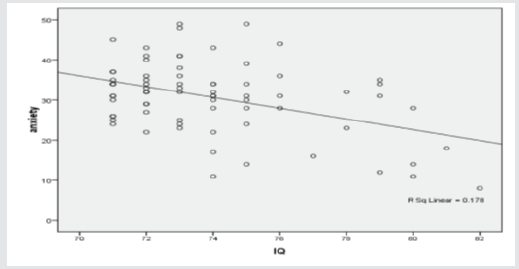
Table 1: Significant difference between the three groups A, B and C (mild, moderate and severe hearing impairment) as regard the total language age.
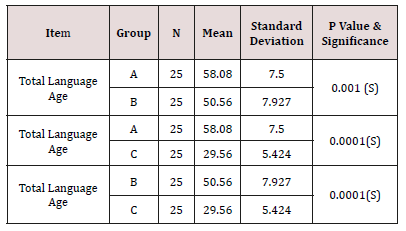
Table 2: Significant difference between the three groups A, B and C (mild, moderate and sever hearing impairment) as regard the IQ scores.
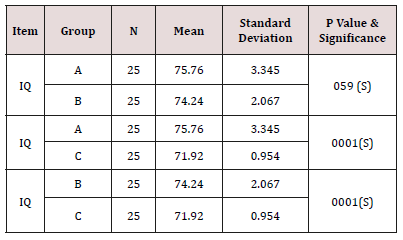
Discussion
Hearing is critical for normal development and acquisition of language and speech. Hearing impairment in children may affect the development of behavior and language and can cause work related difficulties for adults [15]. Hearing loss brings with it some emotions and psychological problems before acceptance of the loss. These emotions can include denial and anger, as well as a sense of isolation [16]. All children with different degrees of hearing impairment had delayed language development and this can be explained by the interference of hearing impairment with the child detection and recognition of speech as well as the development of auditory skills that are prerequisites of the development of receptive and expressive language skills, as well as speech intelligibility [17]. Such auditory skills include detection, discrimination, recognition, comprehension, and attention and in turn, a delay in the early development of these auditory skills caused by hearing loss negatively impacts child’s ability. To learn and use an auditory-oral language system [18]. Strong positive associations between the degree of hearing impairment and language skills were proved and mild hearing-impaired children had better receptive and expressive language than the other two groups. So, their total language ages were highest than the other two groups. These results were also found by Halliday and Bishop [19] who discovered that even subtle deficits in sound processing can lead to marked impairments in language development and severe hearing impairment in childhood often leads to marked delays and deficits in the acquisition of spoken and written language.
However, children with mild hearing impairment usually attend regular schools and communicate with the others and when these children receive hearing aids, they usually find that school is easier, and their school performance improves. But the other two groups entail not only lowered hearing thresholds, but also distortion of sounds, and this means that language input is partial and degraded in spite of the significant positive correlation between the children chronological ages and their total language ages, the older the child age, the higher the speech perception abilities whatever the degree of hearing impairment and the higher its ability to learn [20]. These results were also found by Halliday and Bishop [19] who discovered that even subtle deficits in sound processing can lead to marked impairments in language development and severe hearing impairment in childhood often leads to marked delays and deficits in the acquisition of spoken and written language. However, children with mild hearing impairment usually attend regular schools and communicate with the others and when these children receive hearing aids, they usually find that school is easier, and their school performance improves. But the other two groups entail not only lowered hearing thresholds, but also distortion of sounds, and this means that language input is partial and degraded in spite of the significant positive correlation between the children chronological ages and their total language ages, the older the child age, the higher the speech perception abilities whatever the degree of hearing impairment and the higher its ability to learn [20]. Children intelligence quotient (IQ) scores and their determinants are generally considered predictors of eventual school performance, quality of life, and psychiatric morbidity. Focusing on the relationships between the cognitive assessment (IQ) and the three groups of the study, it will be found that IQ scores range between below average and dull average in hearing impaired children whatever the degree of hearing impairment with strong positive associations between the IQ score and the degree of hearing impairment as mild hearing impaired children have higher IQ than the other two group which is in agreement with Welch D, Dawes PJ (2007) who discovered that even slight to mild hearing loss (<30db) has been documented to have lifelong effects. Among children with losses <15db HL i.e., whose hearing is considered normal, some research has found that slight fluctuations in auditory perception affect neurocognitive outcomes [21]. Children with severe hearing impairment may have a higher frequency of poor cognitive and academic performance when compared with children with mild or even moderate hearing impairment. Also, the descriptive analysis shows highly significant positive correlation between cognitive assessment (IQ) and total language ages in the hearing-impaired children, the higher the language age the higher the IQ score.
As primary reasons why students with hearing deficits perform, on average, lower than their peers on cognitive assessments such as IQ tests, language and communication skills of these hearing impaired children are often delayed due to their disability and these students’ language skills and reading level are lower than average, which may also affect cognitive skills which was proved by Gallaudet Research Institute (2003) who proved that an estimated 40% of children with hearing loss have additional impairments that affect education and adaptive development and children with hearing impairment may have a higher frequency of language problem and had significantly lower intelligence coefficients when compared with children with normal hearing [22].
The descriptive analysis shows that hearing-impaired children -whatever the degree of hearing impairment fell lonely event if they are mild hearing impaired without significant different between the three groups because children feel that they are different from their peers and start to avoid them. Also limited access to services and exclusion from communication can have a significant impact on everyday life, causing feelings of loneliness, isolation. So, even slight/mild hearing impairment can result in negative consequences for the bio psychosocial development of children who often report feeling lonely, without friends and unhappy in school [23]. Anxiety is a normal human emotion that everyone experiences at times. Many people feel anxious, or nervous, when faced with a problem at work, before taking a test, or making an important decision. Anxiety disorders, however, are different; they can cause such distress that it interferes with a person’s ability to lead a normal life [24].
Hearing impaired children with anxiety disorders had an increased physical and psychological reaction to stress. Their reaction to danger, even if it is a small one, is quicker and stronger [25]. Research question investigated the feeling of anxiety in hearing impaired children and the analysis shows that the three groups has different degrees of anxiety feeling and each group shows number of children with anxiety. Mild hearing-impaired children have less anxiety feeling than the other two groups. Mild hearing-impaired children have less disability and better communication than the other two groups which lead to less stress and anxiety disorder, so the results are expected. Knutson et al. [26] found that the risk for clinically significant emotional distress and anxiety disorder (generalized anxiety disorder, social, separation, school avoidant disorder, and panic disorder; each has its own characteristics and symptoms) was two to four times higher among persons with hearing impairment than among persons with normal hearing. These results were also founded by Castrogiovanni [27] who found that school-aged children with any degree of hearing impairment have academic, social, emotional and behavioral difficulties because hearing impaired children, even with a minor degree, often miss information during play and are a target for bullying (person who is curl to other). Strong negative correlation between language and cognitive scale with anxiety disorder is expected that hearing impaired children, who experience significant disruptions in auditory input, are likely to show delays not only in the production of oral language but in other important aspects of development such as anxiety, emotion and behavioral control. With regard to socio-emotional aspects, Zandberg [28] studies have reported that hearing impaired children encounter difficulties acquiring spoken language, which often affects their communication abilities and social development. In turn, the children’s friendship relations and social feelings and mild hearing-impaired children have better language and cognitive scale than moderate or severe ones and the more the affected the child with hearing impairment the more the behavior problem and anxiety disorder or even other psychological interruptions. In addition to a small samples size, the limitations differed across a variety of factors such as duration of deafness, previous degree of benefit from hearing aids, mode of communication, device settings, and age.
Conclusion
Children with hearing impairment-whatever its degreeface multiple concurrent health, developmental, communicative and exhibit anxiety and emotional problems when they do not understand what is going on around them. Without appropriate interventions, these children are at risk of developing mental health disorders.
References
- Schacter Daniel L (2011) Psychology. Worth Publishers.
- Moeller M (2000) Early intervention and language development in Children who are deaf and hard of hearing. Pediatrics 106: 1-9.
- Kral A, O Donoghue GM (2010) Profound deafness in childhood. The New England Journal of Medicine 363: 1438-1450.
- Smith AW (2001) WHO activities for prevention of deafness and Hearing impairment in children. Scand Audiol Suppl 30: 93-100.
- Korver AMH, Admiraal RJC, Kant SG, Dekker FW, Wever CC, et al. (2011) DECIBEL-Collaborative Study Group Causes of permanent Childhood Hearing impairment. Laryngoscope 121: 409-416.
- Morita N (2009) Language, culture, gender, and academic Socialization. Language and education 23: 443-460.
- Margolis (2001) Implications of Prelingual Deafness. Lancet 358: 76.
- Clegg J, Hollis C, Mawhood L, Rutter M (2005) Developmental Language Disorders-a follow-up in later adult life Cognitive, language and Psychosocial outcomes. J Child Psychol Psychiatry 46: 128-149.
- Wolters N, Knoors HET, Cillessen AHN, Verhoeven L (2012) Impact of Peer and teacher relations on deaf early adolescents' well-being: Comparisons before and after a major school transition. J Deaf Stud Deaf Educe 17: 463-482.
- Culpepper M, Kamps D, Wendland M (2006) Active teacher Participation in functional behavior assessments for students with Emotional behavior disorders risks in general education classrooms. Behavior Disorders 31: 128-146.
- Gillham B (2008) Developing a questionnaire (2nd Edn) Continuum International Publishing Group Ltd, London, UK.
- Thorndike RL, Sattler JM (1986) The Stanford – Binet Intelligence Scale. (4th edn), Riverside Publishing Company, Chicago.
- Sady SR, Shoubary AM, Hafez NG, Mohamed AA (2011) Modified Preschool Language Scale. (4th edition) Unpublished Doctoral Thesis (MD thesis), Faculty of Medicine, Ain Shams University.
- Birmaher B, Khetarpal S, Brent D, Cully M, Balach L (1997) The Screen for Child Anxiety Related Emotional Disorders (SCARED): Scale Construction and psychometric Characteristics. J Am Acad Child Adolescent Psychiatry 36: 545-553.
- Ishine M, Okumiya K, Matsubayashi K (2007) A close association Between hearing impairment and activities of daily living, depression, And Quality of life in community-dwelling older people in Japan. J Am Geriatr Soc 55: 316-317.
- Keogh T, Kei J, Driscoll C, Khan A (2010) Children with Minimal Conductive Hearing Impairment: Speech Comprehension in Noise. Audiol Neurotol 15: 27-35.
- Kennison, Shelia (2013) Introduction to language development. Sage, Los Angeles, USA.
- Hagberg BS, Miniscalco C, Gillberg C (2010) Clinic attendees with Autism or attention-deficit/hyperactivity disorder: cognitive profile at School age and its relationship to preschool indicators of language delay. Res Dev Disable 31: 1-8.
- Halliday LF, Bishop DVM (2006) Is poor frequency modulation Detection linked to literacy problems? A comparison of specific reading Disability and mild to moderate sensorineural hearing loss. Brain and Language 97: 200-213.
- Clearfield MW, Osborne CN, Mullen M (2008) Learning by looking: Infants’ social looking behavior across the transition from crawling to Walking. J Exp Child Psychol 100: 297-307.
- Welch D, Dawes PJ (2007) Variation in the normal hearing threshold predicts childhood IQ, linguistic, and behavioral outcomes. Pediatric Res 61: 737-44.
- Gallaudet Research Institute (2003) Regional and National Summary Report of Data from the 2003-2004 Annual Survey of Deaf and Hard of Hearing children and Youth.
- Coplan RJ, Closson LM, Arbeau KA (2007) Gender differences in the Behavioral associates of loneliness and social dissatisfaction in Kindergarten. J Child Psychol Psychiatry 48: 988-995.
- Affruntil NW, Ginsburg GS (2012) Maternal Over control and Child Anxiety: The Mediating Role of Perceived Competence. Child Psychiatry Hum Dev 43(1): 102-112.
- Rieffe C, Meerum Terwogt M (2006) Anger communication in deaf Children. Cogn Emot 20: 1261-1273.
- Knutson JF, Johnson CR, Sullivan PM (2004) Disciplinary choices of Mothers of deaf children and mothers of normally hearing Children. Child Abuse & Neglect 28: 925-937.
- Castrogiovanni A (2004) Incidence and prevalence of hearing Loss and Hearing aid use in the US.
- Zandberg S (2005) Educating children with hearing impairment: Targets And their realization, Jerusalem.

Top Editors
-

Mark E Smith
Bio chemistry
University of Texas Medical Branch, USA -

Lawrence A Presley
Department of Criminal Justice
Liberty University, USA -

Thomas W Miller
Department of Psychiatry
University of Kentucky, USA -

Gjumrakch Aliev
Department of Medicine
Gally International Biomedical Research & Consulting LLC, USA -

Christopher Bryant
Department of Urbanisation and Agricultural
Montreal university, USA -

Robert William Frare
Oral & Maxillofacial Pathology
New York University, USA -

Rudolph Modesto Navari
Gastroenterology and Hepatology
University of Alabama, UK -

Andrew Hague
Department of Medicine
Universities of Bradford, UK -

George Gregory Buttigieg
Maltese College of Obstetrics and Gynaecology, Europe -

Chen-Hsiung Yeh
Oncology
Circulogene Theranostics, England -
.png)
Emilio Bucio-Carrillo
Radiation Chemistry
National University of Mexico, USA -
.jpg)
Casey J Grenier
Analytical Chemistry
Wentworth Institute of Technology, USA -
Hany Atalah
Minimally Invasive Surgery
Mercer University school of Medicine, USA -

Abu-Hussein Muhamad
Pediatric Dentistry
University of Athens , Greece

The annual scholar awards from Lupine Publishers honor a selected number Read More...




